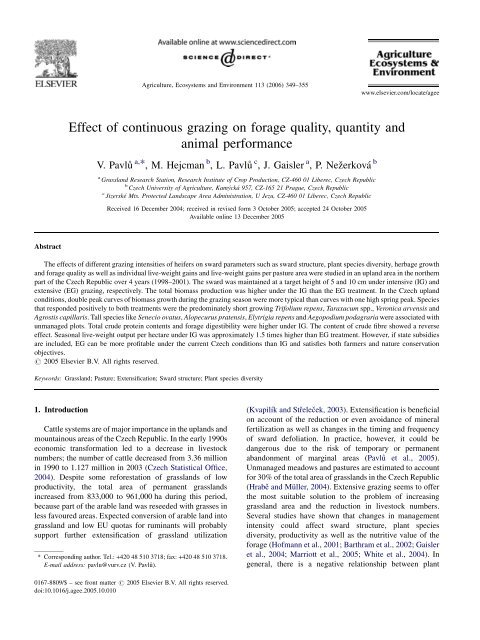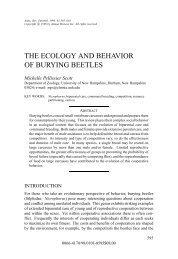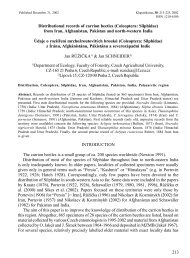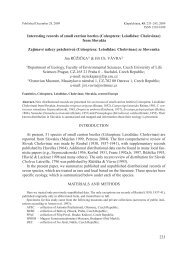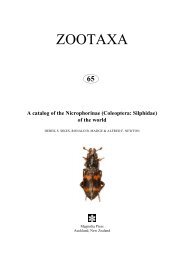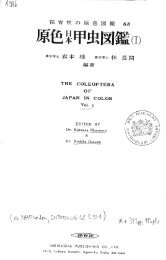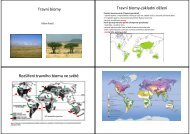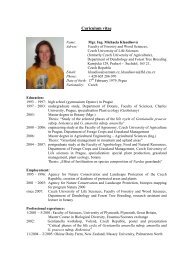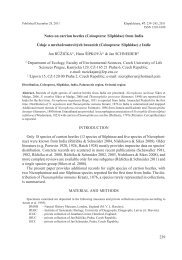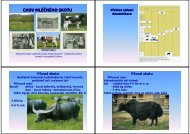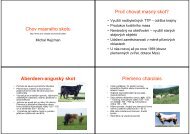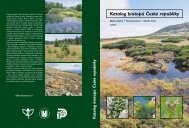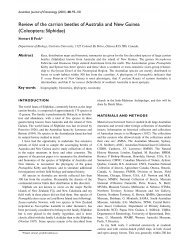Effect of continuous grazing on forage quality, quantity and animal ...
Effect of continuous grazing on forage quality, quantity and animal ...
Effect of continuous grazing on forage quality, quantity and animal ...
You also want an ePaper? Increase the reach of your titles
YUMPU automatically turns print PDFs into web optimized ePapers that Google loves.
Agriculture, Ecosystems <strong>and</strong> Envir<strong>on</strong>ment 113 (2006) 349–355www.elsevier.com/locate/agee<str<strong>on</strong>g>Effect</str<strong>on</strong>g> <str<strong>on</strong>g>of</str<strong>on</strong>g> <str<strong>on</strong>g>c<strong>on</strong>tinuous</str<strong>on</strong>g> <str<strong>on</strong>g>grazing</str<strong>on</strong>g> <strong>on</strong> <strong>forage</strong> <strong>quality</strong>, <strong>quantity</strong> <strong>and</strong><strong>animal</strong> performanceV. Pavlů a, *, M. Hejcman b , L. Pavlů c , J. Gaisler a , P. Nežerková ba Grassl<strong>and</strong> Research Stati<strong>on</strong>, Research Institute <str<strong>on</strong>g>of</str<strong>on</strong>g> Crop Producti<strong>on</strong>, CZ-460 01 Liberec, Czech Republicb Czech University <str<strong>on</strong>g>of</str<strong>on</strong>g> Agriculture, Kamýcká 957, CZ-165 21 Prague, Czech Republicc Jizerské Mts. Protected L<strong>and</strong>scape Area Administrati<strong>on</strong>, U Jezu, CZ-460 01 Liberec, Czech RepublicReceived 16 December 2004; received in revised form 3 October 2005; accepted 24 October 2005Available <strong>on</strong>line 13 December 2005AbstractThe effects <str<strong>on</strong>g>of</str<strong>on</strong>g> different <str<strong>on</strong>g>grazing</str<strong>on</strong>g> intensities <str<strong>on</strong>g>of</str<strong>on</strong>g> heifers <strong>on</strong> sward parameters such as sward structure, plant species diversity, herbage growth<strong>and</strong> <strong>forage</strong> <strong>quality</strong> as well as individual live-weight gains <strong>and</strong> live-weight gains per pasture area were studied in an upl<strong>and</strong> area in the northernpart <str<strong>on</strong>g>of</str<strong>on</strong>g> the Czech Republic over 4 years (1998–2001). The sward was maintained at a target height <str<strong>on</strong>g>of</str<strong>on</strong>g> 5 <strong>and</strong> 10 cm under intensive (IG) <strong>and</strong>extensive (EG) <str<strong>on</strong>g>grazing</str<strong>on</strong>g>, respectively. The total biomass producti<strong>on</strong> was higher under the IG than the EG treatment. In the Czech upl<strong>and</strong>c<strong>on</strong>diti<strong>on</strong>s, double peak curves <str<strong>on</strong>g>of</str<strong>on</strong>g> biomass growth during the <str<strong>on</strong>g>grazing</str<strong>on</strong>g> seas<strong>on</strong> were more typical than curves with <strong>on</strong>e high spring peak. Speciesthat resp<strong>on</strong>ded positively to both treatments were the predominately short growing Trifolium repens, Taraxacum spp., Ver<strong>on</strong>ica arvensis <strong>and</strong>Agrostis capillaris. Tall species like Senecio ovatus, Alopecurus pratensis, Elytrigia repens <strong>and</strong> Aegopodium podagraria were associated withunmanaged plots. Total crude protein c<strong>on</strong>tents <strong>and</strong> <strong>forage</strong> digestibility were higher under IG. The c<strong>on</strong>tent <str<strong>on</strong>g>of</str<strong>on</strong>g> crude fibre showed a reverseeffect. Seas<strong>on</strong>al live-weight output per hectare under IG was approximately 1.5 times higher than EG treatment. However, if state subsidiesare included, EG can be more pr<str<strong>on</strong>g>of</str<strong>on</strong>g>itable under the current Czech c<strong>on</strong>diti<strong>on</strong>s than IG <strong>and</strong> satisfies both farmers <strong>and</strong> nature c<strong>on</strong>servati<strong>on</strong>objectives.# 2005 Elsevier B.V. All rights reserved.Keywords: Grassl<strong>and</strong>; Pasture; Extensificati<strong>on</strong>; Sward structure; Plant species diversity1. Introducti<strong>on</strong>Cattle systems are <str<strong>on</strong>g>of</str<strong>on</strong>g> major importance in the upl<strong>and</strong>s <strong>and</strong>mountainous areas <str<strong>on</strong>g>of</str<strong>on</strong>g> the Czech Republic. In the early 1990sec<strong>on</strong>omic transformati<strong>on</strong> led to a decrease in livestocknumbers; the number <str<strong>on</strong>g>of</str<strong>on</strong>g> cattle decreased from 3.36 milli<strong>on</strong>in 1990 to 1.127 milli<strong>on</strong> in 2003 (Czech Statistical Office,2004). Despite some reforestati<strong>on</strong> <str<strong>on</strong>g>of</str<strong>on</strong>g> grassl<strong>and</strong>s <str<strong>on</strong>g>of</str<strong>on</strong>g> lowproductivity, the total area <str<strong>on</strong>g>of</str<strong>on</strong>g> permanent grassl<strong>and</strong>sincreased from 833,000 to 961,000 ha during this period,because part <str<strong>on</strong>g>of</str<strong>on</strong>g> the arable l<strong>and</strong> was reseeded with grasses inless favoured areas. Expected c<strong>on</strong>versi<strong>on</strong> <str<strong>on</strong>g>of</str<strong>on</strong>g> arable l<strong>and</strong> intograssl<strong>and</strong> <strong>and</strong> low EU quotas for ruminants will probablysupport further extensificati<strong>on</strong> <str<strong>on</strong>g>of</str<strong>on</strong>g> grassl<strong>and</strong> utilizati<strong>on</strong>* Corresp<strong>on</strong>ding author. Tel.: +420 48 510 3718; fax: +420 48 510 3718.E-mail address: pavlu@vurv.cz (V. Pavlů).(Kvapilík <strong>and</strong> Střeleček, 2003). Extensificati<strong>on</strong> is beneficial<strong>on</strong> account <str<strong>on</strong>g>of</str<strong>on</strong>g> the reducti<strong>on</strong> or even avoidance <str<strong>on</strong>g>of</str<strong>on</strong>g> mineralfertilizati<strong>on</strong> as well as changes in the timing <strong>and</strong> frequency<str<strong>on</strong>g>of</str<strong>on</strong>g> sward defoliati<strong>on</strong>. In practice, however, it could bedangerous due to the risk <str<strong>on</strong>g>of</str<strong>on</strong>g> temporary or permanentab<strong>and</strong><strong>on</strong>ment <str<strong>on</strong>g>of</str<strong>on</strong>g> marginal areas (Pavlů et al., 2005).Unmanaged meadows <strong>and</strong> pastures are estimated to accountfor 30% <str<strong>on</strong>g>of</str<strong>on</strong>g> the total area <str<strong>on</strong>g>of</str<strong>on</strong>g> grassl<strong>and</strong>s in the Czech Republic(Hrabě <strong>and</strong> Müller, 2004). Extensive <str<strong>on</strong>g>grazing</str<strong>on</strong>g> seems to <str<strong>on</strong>g>of</str<strong>on</strong>g>ferthe most suitable soluti<strong>on</strong> to the problem <str<strong>on</strong>g>of</str<strong>on</strong>g> increasinggrassl<strong>and</strong> area <strong>and</strong> the reducti<strong>on</strong> in livestock numbers.Several studies have shown that changes in managementintensity could affect sward structure, plant speciesdiversity, productivity as well as the nutritive value <str<strong>on</strong>g>of</str<strong>on</strong>g> the<strong>forage</strong> (H<str<strong>on</strong>g>of</str<strong>on</strong>g>mann et al., 2001; Barthram et al., 2002; Gaisleret al., 2004; Marriott et al., 2005; White et al., 2004). Ingeneral, there is a negative relati<strong>on</strong>ship between plant0167-8809/$ – see fr<strong>on</strong>t matter # 2005 Elsevier B.V. All rights reserved.doi:10.1016/j.agee.2005.10.010
350V. Pavlů et al. / Agriculture, Ecosystems <strong>and</strong> Envir<strong>on</strong>ment 113 (2006) 349–355species diversity, <strong>forage</strong> <strong>quality</strong> <strong>and</strong> biomass producti<strong>on</strong>,causing in many cases c<strong>on</strong>flicts between farmers <strong>and</strong> naturec<strong>on</strong>servati<strong>on</strong> (Mitchley, 2001; White et al., 2004).Extensive <str<strong>on</strong>g>grazing</str<strong>on</strong>g> promotes selective patch <str<strong>on</strong>g>grazing</str<strong>on</strong>g>,which results in an uneven distributi<strong>on</strong> <str<strong>on</strong>g>of</str<strong>on</strong>g> <str<strong>on</strong>g>grazing</str<strong>on</strong>g> pressure,both within <strong>and</strong> between plant communities <strong>and</strong> plantspecies (Taint<strong>on</strong> et al., 1996; Rook et al., 2004). Patchinesscreated by extensive <str<strong>on</strong>g>grazing</str<strong>on</strong>g> is particularly important fornature c<strong>on</strong>servati<strong>on</strong> if it creates a patchwork in swardstructure (Bakker, 1998; Adler et al., 2001). In practice it is,therefore, desirable to find a type <str<strong>on</strong>g>of</str<strong>on</strong>g> management acceptablefor both agricultural <strong>and</strong> nature c<strong>on</strong>servati<strong>on</strong> targets(Watkins<strong>on</strong> <strong>and</strong> Ormerod, 2001).Although the impact <str<strong>on</strong>g>of</str<strong>on</strong>g> extensificati<strong>on</strong> <strong>on</strong> grassl<strong>and</strong>producti<strong>on</strong> is well documented in studies from westernEurope (e.g. Treweek et al., 1997; Fothergill et al., 2001;Marriott et al., 2002; Garcia et al., 2003), data fromc<strong>on</strong>tinental parts <str<strong>on</strong>g>of</str<strong>on</strong>g> Europe are missing. The main purpose<str<strong>on</strong>g>of</str<strong>on</strong>g> this 4-year study in the Czech upl<strong>and</strong>s was to investigatehow intensive <strong>and</strong> extensive <str<strong>on</strong>g>grazing</str<strong>on</strong>g> affect a wide range <str<strong>on</strong>g>of</str<strong>on</strong>g>sward parameters such as growth rate <str<strong>on</strong>g>of</str<strong>on</strong>g> herbage, <strong>forage</strong>yields, sward structure, plant species diversity <strong>and</strong> <strong>forage</strong><strong>quality</strong>. A further aim <str<strong>on</strong>g>of</str<strong>on</strong>g> the study was to detect individuallive-weight gains <str<strong>on</strong>g>of</str<strong>on</strong>g> heifers <strong>and</strong> live-weight gains per grazedarea under different <str<strong>on</strong>g>grazing</str<strong>on</strong>g> intensities.2. Materials <strong>and</strong> methodsThe experiment was carried out from 1998 to 2001 in anexperimental pasture in the Jizerské Mountains in thenorthern Czech Republic, at an altitude <str<strong>on</strong>g>of</str<strong>on</strong>g> 420 m. Theaverage annual precipitati<strong>on</strong> in the area was 803 mm <strong>and</strong> themean annual temperature was 7.2 8C. The geologicalsubstratum is granite underlying low deep brown soil(cambisol): pH/KCl = 5.1, C ox = 3.9%, available P c<strong>on</strong>tent= 64 mg kg 1 , available K c<strong>on</strong>tent = 95 mg kg 1 <strong>and</strong>available Mg c<strong>on</strong>tent = 92 mg kg 1 . The experimental areawas drained, ploughed <strong>and</strong> reseeded with a highlyproductive grass/clover mixture in the 1980s <strong>and</strong> wasintensively managed by cutting <strong>and</strong> <str<strong>on</strong>g>grazing</str<strong>on</strong>g>. In the early1990s mulching was applied <strong>on</strong>ce a year <strong>on</strong>ly (in August)<strong>and</strong> then the grassl<strong>and</strong> was ab<strong>and</strong><strong>on</strong>ed. There was noagricultural management in the 5 years before the start <str<strong>on</strong>g>of</str<strong>on</strong>g> theexperiment in 1998. The dominant species in 1998 werecomm<strong>on</strong> bent (Agrostis capillaris), meadow foxtail (Alopecuruspratensis), red fescue (Festuca rubra), ground-elder(Aegopodium podagraria) <strong>and</strong> hedge bedstraw (Galiumalbum). No fertilizers were used during the experiment.The pasture was <str<strong>on</strong>g>c<strong>on</strong>tinuous</str<strong>on</strong>g>ly stocked with growingheifers (1998–1999 Czech Pied, 2000–2001 Holstein) <str<strong>on</strong>g>of</str<strong>on</strong>g>150–220 kg initial live-weights. The treatments were:intensive <str<strong>on</strong>g>grazing</str<strong>on</strong>g> (IG), extensive <str<strong>on</strong>g>grazing</str<strong>on</strong>g> (EG) <strong>and</strong>unmanaged c<strong>on</strong>trol (U). The experiment was arranged intwo completely r<strong>and</strong>omized blocks. The paddock area foreach IG <strong>and</strong> EG plot was approximately 0.35 ha, whereas thec<strong>on</strong>trol area was 0.12 ha <strong>on</strong>ly. IG paddocks were grazed bytwo separate herds c<strong>on</strong>sisting <str<strong>on</strong>g>of</str<strong>on</strong>g> four to five heifers, whileEG paddocks were grazed by two separate herds <str<strong>on</strong>g>of</str<strong>on</strong>g> two tothree <strong>animal</strong>s <strong>on</strong>ly. With the excepti<strong>on</strong> <str<strong>on</strong>g>of</str<strong>on</strong>g> the first week <str<strong>on</strong>g>of</str<strong>on</strong>g>the <str<strong>on</strong>g>grazing</str<strong>on</strong>g> seas<strong>on</strong>, no supplementary feed was supplied.The stocking density in the different treatments was adaptedto the target sward height <str<strong>on</strong>g>of</str<strong>on</strong>g> 5 cm (IG) or 10 cm (EG) <strong>and</strong>was maintained by varying the <str<strong>on</strong>g>grazing</str<strong>on</strong>g> area available for thetreatment. To maintain the target sward height, an additi<strong>on</strong>aln<strong>on</strong>-sampled area with the required sward height for both IG<strong>and</strong> EG treatments was added in the course <str<strong>on</strong>g>of</str<strong>on</strong>g> the <str<strong>on</strong>g>grazing</str<strong>on</strong>g>seas<strong>on</strong>. The <str<strong>on</strong>g>grazing</str<strong>on</strong>g> seas<strong>on</strong>s lasted from the end <str<strong>on</strong>g>of</str<strong>on</strong>g> April tothe end <str<strong>on</strong>g>of</str<strong>on</strong>g> October.2.1. Sward samplingSward height was measured using the first c<strong>on</strong>tactmethod (modified point quadrat method) weekly. Measurementswere derived from the first perpendicular c<strong>on</strong>tact <str<strong>on</strong>g>of</str<strong>on</strong>g> al<strong>on</strong>g needle at 0.20 m intervals (Pavlů <strong>and</strong> Velich, 1997).Sward height was calculated as a mean <str<strong>on</strong>g>of</str<strong>on</strong>g> 100 records <strong>on</strong>20 m linear transect across each paddock. Herbage underfour exclosure cages (1 m 1 m) was harvested every 3–5weeks in each paddock. Stable height was 5 <strong>and</strong> 10 cm in IG<strong>and</strong> EG treatment, respectively. The exclosure cages wererelocated after sampling. The sward height under theexclosure cages was adjusted to the target sward height fordifferent treatments after moving. The 3-week period forsampling was used at the beginning <str<strong>on</strong>g>of</str<strong>on</strong>g> the <str<strong>on</strong>g>grazing</str<strong>on</strong>g> seas<strong>on</strong>, a4- <strong>and</strong> 5-week period in late summer <strong>and</strong> autumn,respectively.Relevés were made in permanent 1 m 1 m plots using a<str<strong>on</strong>g>c<strong>on</strong>tinuous</str<strong>on</strong>g> grid <str<strong>on</strong>g>of</str<strong>on</strong>g> nine 0.33 m 0.33 m subplots in fourreplicati<strong>on</strong>s in each paddock. The proporti<strong>on</strong>al cover <str<strong>on</strong>g>of</str<strong>on</strong>g> allvascular species was recorded. Plots were visually estimatedbefore the start <str<strong>on</strong>g>of</str<strong>on</strong>g> <str<strong>on</strong>g>grazing</str<strong>on</strong>g> in May each year from 1998 to2001. An initial estimati<strong>on</strong> was c<strong>on</strong>ducted before the firstexperimental manipulati<strong>on</strong> in order to provide baseline datafor each plot. Nomenclature <str<strong>on</strong>g>of</str<strong>on</strong>g> plant species follows Kubátet al. (2002).Four samples <str<strong>on</strong>g>of</str<strong>on</strong>g> herbage in each treatment were taken byh<strong>and</strong> plucking every week to simulate <str<strong>on</strong>g>grazing</str<strong>on</strong>g> <strong>and</strong> weresubsequently dried for 48 h at 70 8C. After drying, theherbage samples for 2 weeks were mixed <strong>and</strong> analyzed forcrude protein (CP), crude fibre (CF) <strong>and</strong> in vitro digestibilityorganic matter (IVDOM). CP <strong>and</strong> CF were determined byWenden’s method (AOAC, 1984). IVDOM was estimated asthe percentage <str<strong>on</strong>g>of</str<strong>on</strong>g> digested <strong>forage</strong> if fed to a ruminant. Theanalysis <str<strong>on</strong>g>of</str<strong>on</strong>g> digestibility was estimated by Steingass <strong>and</strong>Menke (1986) method. The digesti<strong>on</strong> involved incubating<strong>forage</strong> samples inoculated with rumen fluid for 24 h inVitrogest equipment.The live-weight <str<strong>on</strong>g>of</str<strong>on</strong>g> the heifers was identified by weighingat regular m<strong>on</strong>thly intervals. Performance <str<strong>on</strong>g>of</str<strong>on</strong>g> the heifers wasrecorded until the end <str<strong>on</strong>g>of</str<strong>on</strong>g> September, when extensive <str<strong>on</strong>g>grazing</str<strong>on</strong>g>in the EG treatment was finished.
V. Pavlů et al. / Agriculture, Ecosystems <strong>and</strong> Envir<strong>on</strong>ment 113 (2006) 349–355 3512.2. Data analysisRepeated measures ANOVA was used to evaluatebiomass producti<strong>on</strong>, species diversity, <strong>forage</strong> <strong>quality</strong> <strong>and</strong><strong>animal</strong> performance data.The community resp<strong>on</strong>se was analyzed by c<strong>on</strong>strainedordinati<strong>on</strong>s. The redundancy analysis (RDA, Lepš <strong>and</strong>Šmilauer, 2003) intheCANOCOpackagefollowedbyaM<strong>on</strong>te Carlo permutati<strong>on</strong> test was used to evaluate trendsin plant species compositi<strong>on</strong>. All default parameters inCANOCO were used. A total <str<strong>on</strong>g>of</str<strong>on</strong>g> 999 permutati<strong>on</strong>s <str<strong>on</strong>g>of</str<strong>on</strong>g> theperformed analyses were used. The data form repeatedobservati<strong>on</strong>s with the baseline (measurements performedbefore the introducti<strong>on</strong> <str<strong>on</strong>g>of</str<strong>on</strong>g> <str<strong>on</strong>g>grazing</str<strong>on</strong>g>), thus the interacti<strong>on</strong><str<strong>on</strong>g>of</str<strong>on</strong>g> treatments <strong>and</strong> year are the most important variables.The mean <str<strong>on</strong>g>of</str<strong>on</strong>g> nine subplots was used for statisticalevaluati<strong>on</strong>. A biplot ordinati<strong>on</strong> diagram c<strong>on</strong>structed bythe CanoDraw program was used to visualize the results <str<strong>on</strong>g>of</str<strong>on</strong>g>the analyses.3. ResultsThe mean sward heights were 5.8, 4.4, 5.2 <strong>and</strong> 5.3 cmunder IG <strong>and</strong> 9.7, 8.8, 10.3 <strong>and</strong> 10.8 under EG in 1998, 1999,2000 <strong>and</strong> 2001, respectively. There was greater variability insward height in the EG treatment than in the IG treatment,both within the different m<strong>on</strong>thly measurements <strong>and</strong> acrossthe growing seas<strong>on</strong>. The seas<strong>on</strong>al pattern <str<strong>on</strong>g>of</str<strong>on</strong>g> biomass growthwas similar under both treatments, but mostly higher underIG (Fig. 1a). There were significant differences betweentreatments except in 2001 (Table 1). Peak <str<strong>on</strong>g>of</str<strong>on</strong>g> biomassproducti<strong>on</strong> was found in May <strong>and</strong> a significant seas<strong>on</strong>aldevelopment (effect <str<strong>on</strong>g>of</str<strong>on</strong>g> time) was recorded in all <str<strong>on</strong>g>grazing</str<strong>on</strong>g>seas<strong>on</strong>s. There was significant interacti<strong>on</strong> <str<strong>on</strong>g>of</str<strong>on</strong>g> time <strong>and</strong>treatments indicating a n<strong>on</strong>-parallel biomass growth within aseas<strong>on</strong> under the IG <strong>and</strong> EG treatments in 1999 <strong>and</strong> 2000.The summer peak <str<strong>on</strong>g>of</str<strong>on</strong>g> biomass producti<strong>on</strong> was higher than inspring under IG during these years.Forage yields were significantly higher under IG(P < 0.01) <strong>and</strong> the significant effect <str<strong>on</strong>g>of</str<strong>on</strong>g> a year (P = 0.006)showed their seas<strong>on</strong>al variati<strong>on</strong>. Mean <strong>forage</strong> yield was 3.65(S.E. 0.07), 3.90 (S.E. 0.26), 3.33 (S.E. 0.18) <strong>and</strong> 3.42 (S.E.0.28) t ha 1 under IG, whereas values <str<strong>on</strong>g>of</str<strong>on</strong>g> 2.61 (S.E. 0.09),3.07 (S.E. 0.18), 2.20 (S.E. 0.10) <strong>and</strong> 3.35 (S.E. 0.29) werefound under EG in 1998, 1999, 2000 <strong>and</strong> 2001, respectively.There was a significant effect <str<strong>on</strong>g>of</str<strong>on</strong>g> treatments <strong>on</strong> plantspecies compositi<strong>on</strong> (see Table 2, analysis A1 for details).Campanula rotundifolia, A. capillaris, Cerastium holosteoides,Ver<strong>on</strong>ica serpyllifolia <strong>and</strong> Ranunculus repens werespecies which thrived under IG (see Fig. 2). Poa pratensis<strong>and</strong> Plantago lanceolata were species associated with EG.Taraxacum spp., Trifolium repens <strong>and</strong> Cirsium palustrewere supported by both management treatments. Elytrigiarepens, Senecio ovatus, Cirsium arvense, G. album <strong>and</strong> A.podagraria were most comm<strong>on</strong> in the unmanaged c<strong>on</strong>trol.Fig. 1. Seas<strong>on</strong>al patterns <str<strong>on</strong>g>of</str<strong>on</strong>g>: (a) biomass growth rate (g <str<strong>on</strong>g>of</str<strong>on</strong>g> dry matterm 2 day 1 ), (b) crude protein (g kg 1 <str<strong>on</strong>g>of</str<strong>on</strong>g> dry matter) <strong>and</strong> (c) crude fibre(g kg 1 <str<strong>on</strong>g>of</str<strong>on</strong>g> dry matter) under intensive (IG) <strong>and</strong> extensive <str<strong>on</strong>g>grazing</str<strong>on</strong>g> (EG) forthe seas<strong>on</strong>s 1998–2001.There was also a remarkable successi<strong>on</strong>al developmentindependent <str<strong>on</strong>g>of</str<strong>on</strong>g> the experimental treatments (see Table 2,analysis A2 for details). T. repens, Taraxacum spp., Ver<strong>on</strong>icaarvensis, C. holosteoides <strong>and</strong> A. capillaris increased theirTable 1Results <str<strong>on</strong>g>of</str<strong>on</strong>g> repeated measurements—ANOVA analyses <str<strong>on</strong>g>of</str<strong>on</strong>g> biomass producti<strong>on</strong>within <str<strong>on</strong>g>grazing</str<strong>on</strong>g> seas<strong>on</strong>sYear <str<strong>on</strong>g>Effect</str<strong>on</strong>g> Degrees <str<strong>on</strong>g>of</str<strong>on</strong>g> F-ratio P-valuefreedom1998 Treatment 1 44.93 >0.001Time 7 41.52 >0.001Treatment time 7 1.08 0.381999 Treatment 1 6.86 0.02Time 7 35.35 >0.001Treatment time 7 4.01 0.0012000 Treatment 1 28.60 >0.001Time 8 17.88 >0.001Treatment time 8 1.97 0.052001 Treatment 1 0.03 0.87Time 5 42.00 >0.001Treatment time 5 1.96 0.095
352V. Pavlů et al. / Agriculture, Ecosystems <strong>and</strong> Envir<strong>on</strong>ment 113 (2006) 349–355Table 2Results <str<strong>on</strong>g>of</str<strong>on</strong>g> RDA analyses <str<strong>on</strong>g>of</str<strong>on</strong>g> plant species compositi<strong>on</strong> dataTestedhypothesisA1: Is there a difference in developmentbetween treatments? YesA2: Is there a successi<strong>on</strong>al trend inspecies compositi<strong>on</strong>? YesExplanatoryvariablesYear IG, year EG, year UYearCovariables%ExplainedvariabilityF-ratioP-valueYear, PlotID 18.1 (20.1) 15.3 (8.7) 0.001Year IG, year EG, year U, PlotID15.8 21.8 0.001IG, intensive <str<strong>on</strong>g>grazing</str<strong>on</strong>g>; EG, extensive <str<strong>on</strong>g>grazing</str<strong>on</strong>g>; U, unmanaged; PlotID, plot identificator; %explained variability = species variability explained by axis 1 (allordinati<strong>on</strong> axes) measure <str<strong>on</strong>g>of</str<strong>on</strong>g> explanatory power <str<strong>on</strong>g>of</str<strong>on</strong>g> the explanatory variables; F-ratio, F-statistics for the test <str<strong>on</strong>g>of</str<strong>on</strong>g> particular analysis (all axes); P-value,corresp<strong>on</strong>ding probability value obtained by the M<strong>on</strong>te Carlo permutati<strong>on</strong> test (999 permutati<strong>on</strong>s), i.e. type I error probability in testing the hypothesis that theeffect <str<strong>on</strong>g>of</str<strong>on</strong>g> <strong>on</strong>e (all) explanatory variables is zero.cover during the study period, whereas S. ovatus, A.pratensis, E. repens, A. podagraria, Phleum pratense <strong>and</strong>Poa annua showed an opposite trend. This result indicates areplacing <str<strong>on</strong>g>of</str<strong>on</strong>g> tall dominants by short grasses <strong>and</strong> prostrateforbs. The total plant species diversity increased under bothgrazed treatments in comparis<strong>on</strong> with unmanaged plots(Fig. 3).3.1. Forage <strong>quality</strong> <strong>and</strong> <strong>animal</strong> performanceGrazing intensity significantly affected <strong>forage</strong> <strong>quality</strong>(Table 3). Average CP c<strong>on</strong>tents were higher in the IGtreatment than in the EG treatment with the excepti<strong>on</strong> <str<strong>on</strong>g>of</str<strong>on</strong>g> July1998, June 2000 <strong>and</strong> May 2001 <strong>on</strong>ly (Fig. 1b). Averagecrude fibre c<strong>on</strong>tents exhibited a reverse trend (Fig. 1c).Excepti<strong>on</strong>s were July 1998 <strong>and</strong> June 2000 <strong>on</strong>ly. As ac<strong>on</strong>sequence the digestibility <str<strong>on</strong>g>of</str<strong>on</strong>g> organic matter was mostlyhigher in the IG than in the EG treatment. The effect <str<strong>on</strong>g>of</str<strong>on</strong>g> yearFig. 3. Number <str<strong>on</strong>g>of</str<strong>on</strong>g> plant species per 1 m 2 as a functi<strong>on</strong> <str<strong>on</strong>g>of</str<strong>on</strong>g> management.IG—intensive <str<strong>on</strong>g>grazing</str<strong>on</strong>g>, EG—extensive <str<strong>on</strong>g>grazing</str<strong>on</strong>g>, U—unmanaged c<strong>on</strong>trol.St<strong>and</strong>ard errors are indicated by the vertical lines.was significant for all investigated <strong>quality</strong> parameters,indicating high year-to-year variability <str<strong>on</strong>g>of</str<strong>on</strong>g> <strong>quality</strong> parametersover the investigated <str<strong>on</strong>g>grazing</str<strong>on</strong>g> seas<strong>on</strong>s. The significant effect<str<strong>on</strong>g>of</str<strong>on</strong>g> m<strong>on</strong>th showed seas<strong>on</strong>al changes in <strong>quality</strong> parameterswith excepti<strong>on</strong> <str<strong>on</strong>g>of</str<strong>on</strong>g> CP <strong>on</strong>ly. There was also a significantinteracti<strong>on</strong> between treatment <strong>and</strong> m<strong>on</strong>th <strong>and</strong> between year<strong>and</strong> m<strong>on</strong>th. The first interacti<strong>on</strong> indicated a n<strong>on</strong>-parallelFig. 2. Ordinati<strong>on</strong> diagram showing the results <str<strong>on</strong>g>of</str<strong>on</strong>g> RDA analysis <str<strong>on</strong>g>of</str<strong>on</strong>g> plantspecies compositi<strong>on</strong> data. Abbreviati<strong>on</strong>s: * Interacti<strong>on</strong> <str<strong>on</strong>g>of</str<strong>on</strong>g> envir<strong>on</strong>mentalvariables, Aegpo—Aegopodium podagraria, Agrcap—Agrostis capillaris,Camrot—Campanula rotundifolia, Cerhol—Cerastium holosteoides,Cirar—Cirsium arvense, Cirpa—Cirsium palustre, Elyrep—Elytrigiarepens, Festrub—Festuca rubra, Galal—Galium album, Planlan—Plantagolanceolata, Poapr—Poa pratensis, Ranac—Ranunculus acris, Ranrep—Ranunculus repens, Senova—Senecio ovatus, Stegr—Stellaria graminea,Tarspp—Taraxacum spp., Trifrep—Trifolium repens, Verse—Ver<strong>on</strong>ica serpyllifolia.Table 3Results <str<strong>on</strong>g>of</str<strong>on</strong>g> repeated measurements—ANOVA analyses <str<strong>on</strong>g>of</str<strong>on</strong>g> nutrient c<strong>on</strong>tentsin pasture <strong>forage</strong>, IVDOM, in vitro digestibility <str<strong>on</strong>g>of</str<strong>on</strong>g> organic matterVariable <str<strong>on</strong>g>Effect</str<strong>on</strong>g> Degrees <str<strong>on</strong>g>of</str<strong>on</strong>g> F-ratio P-valuefreedomCrude Treatment 4 30.04
V. Pavlů et al. / Agriculture, Ecosystems <strong>and</strong> Envir<strong>on</strong>ment 113 (2006) 349–355 353development <str<strong>on</strong>g>of</str<strong>on</strong>g> parameters under the investigated treatmentswithin the <str<strong>on</strong>g>grazing</str<strong>on</strong>g> seas<strong>on</strong>s. The sec<strong>on</strong>d interacti<strong>on</strong>showed that the seas<strong>on</strong>al development <str<strong>on</strong>g>of</str<strong>on</strong>g> parametersdiffered between years.A significant effect <str<strong>on</strong>g>of</str<strong>on</strong>g> <str<strong>on</strong>g>grazing</str<strong>on</strong>g> intensity (P = 0.013) <strong>on</strong>daily live-weight gains per head was revealed. Average dailylive-weight gains per head were 754, 916, 842 <strong>and</strong> 794 gunder IG <strong>and</strong> 979, 1080, 836 <strong>and</strong> 764 g under EG treatmentin 1998, 1999, 2000 <strong>and</strong> 2001, respectively. The averageseas<strong>on</strong>al live-weight output per hectare reached values <str<strong>on</strong>g>of</str<strong>on</strong>g>412, 338, 351 <strong>and</strong> 351 kg ha 1 in the IG treatment, whereasvalues <str<strong>on</strong>g>of</str<strong>on</strong>g> 330, 194, 211 <strong>and</strong> 243 kg ha 1 were found in theEG treatment in 1998, 1999, 2000 <strong>and</strong> 2001, respectively. Asignificant effect <str<strong>on</strong>g>of</str<strong>on</strong>g> treatment (P = 0.027) <strong>and</strong> year(P = 0.015) but n<strong>on</strong>-significant interacti<strong>on</strong> between treatment<strong>and</strong> year for live-weight output per hectare wasrevealed.The mean stocking rates over the <str<strong>on</strong>g>grazing</str<strong>on</strong>g> seas<strong>on</strong> were967, 1141, 962 <strong>and</strong> 1024 kg ha 1 under IG <strong>and</strong> 697, 576,610 <strong>and</strong> 532 under EG in 1998, 1999, 2000 <strong>and</strong> 2001,respectively.4. Discussi<strong>on</strong>Actual sward heights were influenced by either avoidedor infrequently grazed sward comp<strong>on</strong>ents particularly <strong>on</strong>extensively grazed plots, where a higher variability <str<strong>on</strong>g>of</str<strong>on</strong>g> theactual sward height was found due to selective <str<strong>on</strong>g>grazing</str<strong>on</strong>g>. Inspite <str<strong>on</strong>g>of</str<strong>on</strong>g> sward height variability in the EG plots a doublenormal distributi<strong>on</strong> <str<strong>on</strong>g>of</str<strong>on</strong>g> sward heights was not found as wasrecorded for lightly grazed pastures by Gibb <strong>and</strong> Ridout(1986, 1988).The shape <str<strong>on</strong>g>of</str<strong>on</strong>g> curves for aboveground biomass producti<strong>on</strong>was similar under both treatments with a summer decreaseprobably due to unbalanced precipitati<strong>on</strong> during the <str<strong>on</strong>g>grazing</str<strong>on</strong>g>seas<strong>on</strong>s. Reducti<strong>on</strong> in biomass growth rate was found in Junein all years. The sec<strong>on</strong>d peak occurred in July <strong>and</strong>/or Augustaccompanied by higher temperature c<strong>on</strong>nected with higherprecipitati<strong>on</strong>. This sec<strong>on</strong>d growth peak was more remarkableunder IG, where it was even higher than the spring peak.Based <strong>on</strong> the results it can be assumed that the curve witha double peak was more typical during the experiment than<strong>on</strong>e peak traditi<strong>on</strong>ally shown by seaside (Orr et al., 1988)aswell as Czech authors (Velich, 1991). Double peak curvesoccurred three times during the four experiment seas<strong>on</strong>s inthis study. Total yields <str<strong>on</strong>g>of</str<strong>on</strong>g> herbage were relatively low <strong>and</strong>according to Velich’s (1991) classificati<strong>on</strong>, the experimentalgrassl<strong>and</strong> is designated as low productivity under Czechc<strong>on</strong>diti<strong>on</strong>s.Tall species (E. repens, A. podagraria, S. ovatus, G.album) were dominant in the unmanaged grassl<strong>and</strong>.Similarly, Kahmen <strong>and</strong> Poschlod (2004) <strong>and</strong> Pykälä(2005) observed an increase <str<strong>on</strong>g>of</str<strong>on</strong>g> tall species (>0.6 m) innumber as well as in abundance in ab<strong>and</strong><strong>on</strong>ed grassl<strong>and</strong>. EGresulted in an increase in variability <str<strong>on</strong>g>of</str<strong>on</strong>g> sward height. Asimilar variability under EG was documented by Bakker(1989, 1998) in temperate grassl<strong>and</strong>s. T. repens, Taraxacumspp., F. rubra <strong>and</strong> R. repens are species tolerant to heavy<str<strong>on</strong>g>grazing</str<strong>on</strong>g> usually dominant in short swards (Correll et al.,2003; Matějková et al., 2003; Pavlů et al., 2003). Theyoccurred in both treatments in the experiment, predominatelyin the heavily grazed sward. In terms <str<strong>on</strong>g>of</str<strong>on</strong>g> abundance,<str<strong>on</strong>g>grazing</str<strong>on</strong>g> at the small scale seems to be more important thanthe intensity <str<strong>on</strong>g>of</str<strong>on</strong>g> <str<strong>on</strong>g>grazing</str<strong>on</strong>g> management at the scale <str<strong>on</strong>g>of</str<strong>on</strong>g> thewhole paddock. The successive increase in time (see Fig. 3)<str<strong>on</strong>g>of</str<strong>on</strong>g> A. capillaris <strong>and</strong> prostrate herbs (T. repens, Taraxacumspp.) in grazed plots was in accordance with the findings <str<strong>on</strong>g>of</str<strong>on</strong>g>Belsky (1992) <strong>and</strong> Mitchley (1988) that the replacement <str<strong>on</strong>g>of</str<strong>on</strong>g>tall grasses by mid or short grasses occurs under frequentdefoliati<strong>on</strong>. An increase <str<strong>on</strong>g>of</str<strong>on</strong>g> plant species diversity at a scale<str<strong>on</strong>g>of</str<strong>on</strong>g> 1 m 2 occurred after introducti<strong>on</strong> <str<strong>on</strong>g>of</str<strong>on</strong>g> grazers. This is inaccordance with the findings in many studies performed <strong>on</strong>mesic grassl<strong>and</strong>s (e.g. Krahulec et al., 2001; Bakker et al.,2003; Hellström et al., 2003).The significant differences in the parameters <str<strong>on</strong>g>of</str<strong>on</strong>g> <strong>forage</strong><strong>quality</strong> (CF, CP <strong>and</strong> IVDOM) were influenced by differencesin the sward heights. H<str<strong>on</strong>g>of</str<strong>on</strong>g>mann et al. (2001) as well as Audicet al. (2002) dem<strong>on</strong>strated that herbage from extensivelymanaged swards showed c<strong>on</strong>siderably lower nutriti<strong>on</strong>alvalues than that from the intensively managed <strong>on</strong>es. Inintensively grazed paddocks the heifers mostly grazed low,younger biomass <strong>and</strong> plants remained in the vegetativestage, whereas in the extensively grazed treatment heifershad the choice <str<strong>on</strong>g>of</str<strong>on</strong>g> both young <strong>and</strong> mature reproductiveplants. EG resulted in the creati<strong>on</strong> <str<strong>on</strong>g>of</str<strong>on</strong>g> a variable sward withlightly grazed taller <strong>and</strong> heavily grazed shorter tufts withdifferent herbage <strong>quality</strong>. In the temperate European climatethe decline in herbage use results in a taller <strong>and</strong> lessdigestible vegetati<strong>on</strong> (Louault et al., 2002), in which thec<strong>on</strong>tent <str<strong>on</strong>g>of</str<strong>on</strong>g> senesced/dead material seems to have a highinfluence <strong>on</strong> digestibility <str<strong>on</strong>g>of</str<strong>on</strong>g> organic matter (Søegaard,2002). For these reas<strong>on</strong>s r<strong>and</strong>om h<strong>and</strong> plucking <str<strong>on</strong>g>of</str<strong>on</strong>g> thepasture vegetati<strong>on</strong> cannot reflect an actual selectively grazedsward <strong>and</strong> cannot comprise a further range <str<strong>on</strong>g>of</str<strong>on</strong>g> factors such as<str<strong>on</strong>g>grazing</str<strong>on</strong>g> selectivity <str<strong>on</strong>g>of</str<strong>on</strong>g> particular species, preference <str<strong>on</strong>g>of</str<strong>on</strong>g> leavesto stems or avoidance <str<strong>on</strong>g>of</str<strong>on</strong>g> areas c<strong>on</strong>taminated by urine (J<strong>on</strong>es<strong>and</strong> Moseley, 1993).The live-weight gains per head <str<strong>on</strong>g>of</str<strong>on</strong>g> grazed heifers revealedin this study are comparable with the data published fromCzech c<strong>on</strong>diti<strong>on</strong>s (Pavlů <strong>and</strong> Velich, 1997). There was atendency to have higher daily live-weight gains <str<strong>on</strong>g>of</str<strong>on</strong>g> milk–beefbreed (Czech Pied) under EG <strong>and</strong> the milk breed (Holstein)under IG, however due to the low number <str<strong>on</strong>g>of</str<strong>on</strong>g> <strong>animal</strong>s usedduring the experiment it is difficult to generalize thesefindings. As a result <str<strong>on</strong>g>of</str<strong>on</strong>g> approximately two times higherstocking rate the total live output <str<strong>on</strong>g>of</str<strong>on</strong>g> heifers per hectare in theIG treatment was about <strong>on</strong>e <strong>and</strong> a half times higher. Thisfinding corresp<strong>on</strong>ds with the c<strong>on</strong>clusi<strong>on</strong>s <str<strong>on</strong>g>of</str<strong>on</strong>g> Thériez et al.(1997) <strong>and</strong> H<str<strong>on</strong>g>of</str<strong>on</strong>g>mann et al. (2001) that the <strong>animal</strong> producti<strong>on</strong>per area unit is markedly reduced under EG, but theindividual <strong>animal</strong> performance is relatively similar under
354V. Pavlů et al. / Agriculture, Ecosystems <strong>and</strong> Envir<strong>on</strong>ment 113 (2006) 349–355both extensive <strong>and</strong> intensive management. This c<strong>on</strong>trastingrelati<strong>on</strong>ship between stocking rate <strong>and</strong> individuallive-weight gains has also been recorded in an experimentutilising sheep (Barthram et al., 2002). Using a comm<strong>on</strong>market value <str<strong>on</strong>g>of</str<strong>on</strong>g> heifers (s0.9 kg 1 , Czech StatisticalOffice, 2004) the value <str<strong>on</strong>g>of</str<strong>on</strong>g> live-weight gains wouldbe s376 <strong>and</strong> s251 ha 1 in IG <strong>and</strong> EG, respectively.Including a state subsidy <str<strong>on</strong>g>of</str<strong>on</strong>g> s96 ha 1 for grassl<strong>and</strong>extensificati<strong>on</strong>, EG has the potential to be morepr<str<strong>on</strong>g>of</str<strong>on</strong>g>itable, if a larger area is managed with the same herdsize.To avoid an increase <str<strong>on</strong>g>of</str<strong>on</strong>g> fallow l<strong>and</strong> area, EG appears to begood l<strong>and</strong>scape management tool in the grassl<strong>and</strong> dominatedregi<strong>on</strong>s in the Czech Republic. In spite <str<strong>on</strong>g>of</str<strong>on</strong>g> lower <strong>forage</strong><strong>quality</strong>, EG may meet the dem<strong>and</strong>s <str<strong>on</strong>g>of</str<strong>on</strong>g> grazers thoughproviding sufficient producti<strong>on</strong> per head. A balancedstocking rate <strong>and</strong> herbage producti<strong>on</strong> is particularly difficultdue to the high variability <str<strong>on</strong>g>of</str<strong>on</strong>g> biomass growth during the<str<strong>on</strong>g>grazing</str<strong>on</strong>g> seas<strong>on</strong>s. Extensive <strong>and</strong> intensive <str<strong>on</strong>g>grazing</str<strong>on</strong>g> resulted inan increase <str<strong>on</strong>g>of</str<strong>on</strong>g> small-scale plant species diversity in c<strong>on</strong>trastto unmanaged plots dominated by tall species <strong>on</strong>ly.However, this can <strong>on</strong>ly be achieved with the help <str<strong>on</strong>g>of</str<strong>on</strong>g>ec<strong>on</strong>omic support for extensive systems, e.g. ‘‘the extensivepasture subsidy’’ in the Czech Republic.AcknowledgementsThis research was supported by GACR (grant nos. 521/98/1321, 526/03/0528) <strong>and</strong> MACR 0002700601. We aregrateful to Dalibor Auf, Vlastislav Černý, Věra Ismanická,František Paška <strong>and</strong> Ant<strong>on</strong>ín Urban for help with thefieldwork. We are indebted to Johannes Isselstein for hisuseful comments <strong>and</strong> to Nicky Bruce for her linguisticcorrecti<strong>on</strong>. Language <strong>and</strong> clarity have been also improvedby two an<strong>on</strong>ymous referees, who are gratefully acknowledged.ReferencesAdler, P.B., Raff, D.A., Lauenroth, W.K., 2001. The effect <str<strong>on</strong>g>of</str<strong>on</strong>g> <str<strong>on</strong>g>grazing</str<strong>on</strong>g> <strong>on</strong>spatial heterogenity <str<strong>on</strong>g>of</str<strong>on</strong>g> vegetati<strong>on</strong>. Oecologia 128, 465–479.AOAC, 1984. Official Methods <str<strong>on</strong>g>of</str<strong>on</strong>g> Analysis, 14th ed. Associati<strong>on</strong> <str<strong>on</strong>g>of</str<strong>on</strong>g> OfficialAnalytical Chemists, Washingt<strong>on</strong>, DC, US.Audic, C., Hardy, A., Pelletier, P., 2002. Extensificati<strong>on</strong> <str<strong>on</strong>g>of</str<strong>on</strong>g> grazed pasturesin French suckling cow systems. Grassl<strong>and</strong> Sci. Eur. 7, 1008–1009.Bakker, J.P., 1989. Nature Management by Grazing <strong>and</strong> Cutting. KluwerAcademic Publishers, Dordrecht.Bakker, J.P., 1998. The impact <str<strong>on</strong>g>of</str<strong>on</strong>g> <str<strong>on</strong>g>grazing</str<strong>on</strong>g> <strong>on</strong> plant communities. In: WallisDe Vries, M.F., Bakker, J.P., Van Wieren, S.E. (Eds.), Grazing <strong>and</strong>C<strong>on</strong>servati<strong>on</strong> Management. Kluwer Academic Publisher, Dordrecht,pp. 137–184.Bakker, C., Blair, J.M., Knapp, A.K., 2003. Does resource availability,resource heterogeneity or species turnover mediate changes in plantspecies richness in grazed grassl<strong>and</strong>s? Oecologia 137, 385–391.Barthram, G.T., Marriott, C.A., Comm<strong>on</strong>, T.G., Bolt<strong>on</strong>, G.R., 2002. Thel<strong>on</strong>g-term effects <strong>on</strong> upl<strong>and</strong> sheep producti<strong>on</strong> in the UK <str<strong>on</strong>g>of</str<strong>on</strong>g> a change toextensive management. Grass Forage Sci. 57, 124–136.Belsky, A.J., 1992. <str<strong>on</strong>g>Effect</str<strong>on</strong>g>s <str<strong>on</strong>g>of</str<strong>on</strong>g> <str<strong>on</strong>g>grazing</str<strong>on</strong>g>, competiti<strong>on</strong>, disturbance <strong>and</strong> fire <strong>on</strong>species compositi<strong>on</strong> <strong>and</strong> diversity in grassl<strong>and</strong> communities. J. Veg. Sci.3, 187–200.Correll, O., Isselstein, J., Pavlů, V., 2003. Studying spatial <strong>and</strong> temporaldynamics <str<strong>on</strong>g>of</str<strong>on</strong>g> sward structure at low stocking densities: the use <str<strong>on</strong>g>of</str<strong>on</strong>g> anextended rising-plate-meter method. Grass Forage Sci. 58, 450–454.Czech Statistical Office, 2004. Statistical Yearbook <str<strong>on</strong>g>of</str<strong>on</strong>g> the Czech Republic2003. Prague.Fothergill, M., Davies, D.A., Morgan, C.T., 2001. Extensificati<strong>on</strong> <str<strong>on</strong>g>of</str<strong>on</strong>g> grassl<strong>and</strong>use in the upl<strong>and</strong>s. 1. Sheep performance in years 1–6. GrassForage Sci. 56, 105–117.Gaisler, J., Hejcman, M., Pavlů, V., 2004. <str<strong>on</strong>g>Effect</str<strong>on</strong>g> <str<strong>on</strong>g>of</str<strong>on</strong>g> different mulching <strong>and</strong>cutting regimes <strong>on</strong> the vegetati<strong>on</strong> <str<strong>on</strong>g>of</str<strong>on</strong>g> upl<strong>and</strong> meadow. Plant Soil Envir<strong>on</strong>.50, 324–331.Garcia, F., Carrère, P., Soussana, J.F., Baum<strong>on</strong>t, R., 2003. The ability <str<strong>on</strong>g>of</str<strong>on</strong>g>sheep at different stocking rates to maintain the <strong>quality</strong> <strong>and</strong> <strong>quantity</strong> <str<strong>on</strong>g>of</str<strong>on</strong>g>their diet during the <str<strong>on</strong>g>grazing</str<strong>on</strong>g> seas<strong>on</strong>. J. Agric. Sci. 140, 113–124.Gibb, M.J., Ridout, M.S., 1986. The fitting <str<strong>on</strong>g>of</str<strong>on</strong>g> frequency distributi<strong>on</strong>s toheight measurements <strong>on</strong> grazed swards. Grass Forage Sci. 41, 247–249.Gibb, M.J., Ridout, M.S., 1988. Applicati<strong>on</strong> <str<strong>on</strong>g>of</str<strong>on</strong>g> double normal frequencydistributi<strong>on</strong>s fitted to measurements <str<strong>on</strong>g>of</str<strong>on</strong>g> sward height. Grass Forage Sci.43, 131–136.Hellström, K., Huhta, A.P., Rautio, P., Tuomi, J., Oksanen, J., Laine, K.,2003. Use <str<strong>on</strong>g>of</str<strong>on</strong>g> sheep <str<strong>on</strong>g>grazing</str<strong>on</strong>g> in the restorati<strong>on</strong> <str<strong>on</strong>g>of</str<strong>on</strong>g> semi-natural meadowsin northern Finl<strong>and</strong>. Appl. Veg. Sci. 6, 45–52.H<str<strong>on</strong>g>of</str<strong>on</strong>g>mann, M., Kowarsch, N., B<strong>on</strong>n, S., Isselstein, J., 2001. Management forbiodiversity <strong>and</strong> c<strong>on</strong>sequences for grassl<strong>and</strong> productivity. Grassl<strong>and</strong> Sci.Eur. 6, 113–116.Hrabě, F., Müller, M., 2004. Aktuální problémy pastevní exploatace travníchporostů. In: Sborník z mezinárodní vědecké k<strong>on</strong>ference—Pastvinaa zvíře, MZLU, Brno, pp. 194–203.J<strong>on</strong>es, D.I.H., Moseley, G., 1993. Laboratory methods for estimatingnutritive <strong>quality</strong>. In: Davies, A., Baker, R.D., Grant, S.A., Laidlaw,A.S. (Eds.), Sward Measurement H<strong>and</strong>book. British Grassl<strong>and</strong> Society,Reading, pp. 265–284.Kahmen, S., Poschlod, P., 2004. Plant functi<strong>on</strong>al traits resp<strong>on</strong>ses to grassl<strong>and</strong>ssuccessi<strong>on</strong> over 25 years. J. Veg. Sci. 15, 21–32.Krahulec, F., Skálová, H., Herben, T., Hadincová, V., Wildová, R., Pecháčková,S., 2001. Vegetati<strong>on</strong> changes following sheep <str<strong>on</strong>g>grazing</str<strong>on</strong>g> in ab<strong>and</strong><strong>on</strong>edmountain meadows. Appl. Veg. Sci. 4, 97–102.Kubát, K., Hrouda, L., Chrtek, J., Kaplan, Z., Kirschner, J., Štěpánek, J.(Eds.), 2002. Klíč ke Květeně České republiky. Academia, Praha.Kvapilík, J., Střeleček, F., 2003. Cattle <strong>and</strong> sheep quotas negotiatedbetween the Czech Republic <strong>and</strong> the EU. Czech J. Anim. Sci. 39,487–499.Lepš, J., Šmilauer, P., 2003. Multivariate Analysis <str<strong>on</strong>g>of</str<strong>on</strong>g> Ecological Data UsingCANOCO. Cambridge University Press, Cambridge.Louault, F., Soussana, J.F., Perrodin, M., 2002. L<strong>on</strong>g-term effects <str<strong>on</strong>g>of</str<strong>on</strong>g> areduced herbage use in a semi-natural grassl<strong>and</strong>. I. Plant functi<strong>on</strong>al traits<strong>and</strong> plant resp<strong>on</strong>se groups. Grassl<strong>and</strong> Sci. Eur. 7, 338–339.Marriott, C.A., Bolt<strong>on</strong>, G.R., Barthram, G.T., Fisher, J.M., Hood, K., 2002.Early changes in species compositi<strong>on</strong> <str<strong>on</strong>g>of</str<strong>on</strong>g> upl<strong>and</strong> sown grassl<strong>and</strong> underextensive <str<strong>on</strong>g>grazing</str<strong>on</strong>g> management. Appl. Veg. Sci. 5, 87–98.Marriott, C.A., Bolt<strong>on</strong>, G.R., Fisher, J.M., Hood, K., 2005. Short-termchanges in soil nutrients <strong>and</strong> vegetati<strong>on</strong> biomass <strong>and</strong> nutrient c<strong>on</strong>tentfollowing the introducti<strong>on</strong> <str<strong>on</strong>g>of</str<strong>on</strong>g> extensive management in upl<strong>and</strong> sownswards in Scotl<strong>and</strong>, UK. Agric. Ecosys. Envir<strong>on</strong>. 106, 331–344.Matějková, I., van Diggelen, R., Prach, K., 2003. An attempt to restore aCzech species-rich mountain grassl<strong>and</strong> through <str<strong>on</strong>g>grazing</str<strong>on</strong>g>. Appl. Veg. Sci.6, 161–168.Mitchley, J., 1988. C<strong>on</strong>trol <str<strong>on</strong>g>of</str<strong>on</strong>g> relative abundance <str<strong>on</strong>g>of</str<strong>on</strong>g> perennials in chalkgrassl<strong>and</strong> in southern Engl<strong>and</strong>. II. Vertical canopy structure. J. Ecol. 76,341–350.Mitchley, J., 2001. Species diversity in grassl<strong>and</strong>. In: Shiyomi, M., Koizumi,H. (Eds.), Structure <strong>and</strong> Functi<strong>on</strong> in Agroecosystem Design <strong>and</strong>Management. CRC Press, Boca Rat<strong>on</strong>, pp. 45–59.
V. Pavlů et al. / Agriculture, Ecosystems <strong>and</strong> Envir<strong>on</strong>ment 113 (2006) 349–355 355Orr, R.J., Pars<strong>on</strong>s, A.J., Treacher, T.J., Penning, P.D., 1988. Seas<strong>on</strong>alpatterns <str<strong>on</strong>g>of</str<strong>on</strong>g> grass producti<strong>on</strong> under cutting <strong>and</strong> <str<strong>on</strong>g>c<strong>on</strong>tinuous</str<strong>on</strong>g> stockingmamagement. Grass Forage Sci. 43, 199–207.Pavlů, V., Hejcman, M., Pavlů, L., Gaisler, J., 2003. <str<strong>on</strong>g>Effect</str<strong>on</strong>g> <str<strong>on</strong>g>of</str<strong>on</strong>g> rotati<strong>on</strong>al <strong>and</strong><str<strong>on</strong>g>c<strong>on</strong>tinuous</str<strong>on</strong>g> <str<strong>on</strong>g>grazing</str<strong>on</strong>g> <strong>on</strong> vegetati<strong>on</strong> <str<strong>on</strong>g>of</str<strong>on</strong>g> an upl<strong>and</strong> grassl<strong>and</strong> in the Jizerskehory Mts., Czech Republic. Folia Geobot. 38, 21–34.Pavlů, V., Hejcman, M., Pavlů, L., Gaisler, J., Nežerková, P., GuerovichAndaluz, M., 2005. Vegetati<strong>on</strong> changes after cessati<strong>on</strong> <str<strong>on</strong>g>of</str<strong>on</strong>g> <str<strong>on</strong>g>grazing</str<strong>on</strong>g>management in the Jizerské Mountains (Czech Republic). Ann. Bot.Fenn. 42, 343–349.Pavlů, V., Velich, J., 1997. Sward structure under <str<strong>on</strong>g>c<strong>on</strong>tinuous</str<strong>on</strong>g> <strong>and</strong> rotati<strong>on</strong><str<strong>on</strong>g>grazing</str<strong>on</strong>g>. In: Proceedings <str<strong>on</strong>g>of</str<strong>on</strong>g> the 18th Internati<strong>on</strong>al Grassl<strong>and</strong> C<strong>on</strong>gress,vol. II, Canada, pp. 113–114.Pykälä, J., 2005. Plant species resp<strong>on</strong>ses to cattle <str<strong>on</strong>g>grazing</str<strong>on</strong>g> in mesic seminaturalgrassl<strong>and</strong>. Agric. Ecosys. Envir<strong>on</strong>. 108, 109–117.Rook, A.J., Dum<strong>on</strong>t, B., Isselstein, J., Osoro, K., Wallis De Vries, M.F.,Parente, G., Mills, J., 2004. Matching type <str<strong>on</strong>g>of</str<strong>on</strong>g> livestock to desired biodiversityoutcomes in pastures—a review. Biol. C<strong>on</strong>serv. 119, 137–150.Søegaard, K., 2002. The effect <str<strong>on</strong>g>of</str<strong>on</strong>g> <str<strong>on</strong>g>grazing</str<strong>on</strong>g> management <strong>on</strong> botanical compositi<strong>on</strong><strong>and</strong> herbage <strong>quality</strong> <strong>on</strong> field level. Grassl<strong>and</strong> Sci. Eur. 7, 162–163.Steingass, H., Menke, K.H., 1986. Schätzung des energetischen Futterwertesaus der in vitro mit Pansensaft bestimmten Gasbildung und derchemischen Analyse. 1. Untersuchungen zur Methode Übers Tierernährg14, 251–270.Taint<strong>on</strong>, N.M., Morris, C.D., Hardy, M.B., 1996. Complexity <strong>and</strong> stability in<str<strong>on</strong>g>grazing</str<strong>on</strong>g> systems. In: Hodgs<strong>on</strong>, J., Illius, A.W. (Eds.), The Ecology <strong>and</strong>Management <str<strong>on</strong>g>of</str<strong>on</strong>g> Grazing System. CABI Publishing, Wallingford, pp. 3–36.Thériez, M., Brelurut, A., Pailleux, J.Y., Benoît, M., Liénart, G., Louault, F.,De M<strong>on</strong>tard, F.X., 1997. Extensificati<strong>on</strong> en élevage ovin vi<strong>and</strong>e paragr<strong>and</strong>issement des surfaces fourragères. Résultats zootechniques etéc<strong>on</strong>omiques de 5 ans d’expérience dans le Massif Central Nord. INRAProd. Anim. 10, 141–152.Treweek, J.R., Watt, T.A., Hambler, C., 1997. Integrati<strong>on</strong> <str<strong>on</strong>g>of</str<strong>on</strong>g> sheep producti<strong>on</strong><strong>and</strong> nature c<strong>on</strong>servati<strong>on</strong>: experimental management. J. Envir<strong>on</strong>.Manage. 50, 193–210.Velich, J., 1991. Základy pastevní techniky. In: Velich, J., Petřík, M., Regal,V., Štráfelda, J., Turek, F. (Eds.), Pícninářství. VŠZ, Praha, pp. 180–184.Watkins<strong>on</strong>, A.R., Ormerod, S.J., 2001. Grassl<strong>and</strong>s, <str<strong>on</strong>g>grazing</str<strong>on</strong>g> <strong>and</strong> biodiversity:editor’s introducti<strong>on</strong>. J. Appl. Ecol. 38, 233–237.White, T.A., Barker, D.J., Moore, K.J., 2004. Vegetati<strong>on</strong> diversity, growth,<strong>quality</strong> <strong>and</strong> decompositi<strong>on</strong> in managed grassl<strong>and</strong>s. Agric. Ecosys.Envir<strong>on</strong>. 80, 213–226.


